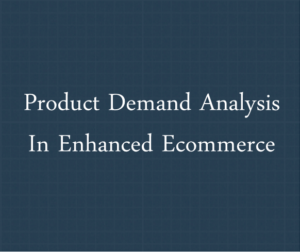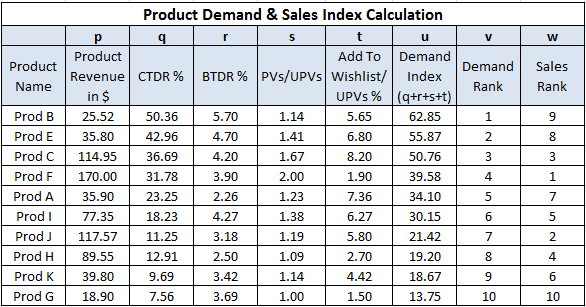
As I explained in my last blog post, Enhanced Ecommerce in Universal Analytics has opened a whole new world with powerful insights but still, the question remains – what actions business owners can take from these insights to generate more revenue?
One of our eCommerce clients raised the same concern when we implemented Enhanced Ecommerce on his store. The client wanted to analyze the performance of his products in terms of their demand and revenue & use the insights generated to improve their product placements, Marketing efforts, and profit margin.
We then carried out a Product Demand analysis for the client in which we used the Products Performance report of Enhanced Ecommerce to calculate product demand. We combined the product demand with product revenue data we generated several actions which had the potential to optimize the client’s revenue.
(Quick Note: You Might want to check out our Google Analytics Plugin for WooCommerce, Magento & Shopify)
In the following blog post, I will walk you through what is Product Demand Index, How the product Demand index is calculated, and what actions you can take from the analysis.
Quick Navigation:
- What is the Product Demand Index
- How to Calculate Product Demand Index using Enhanced Ecommerce
- What Insights/actions you can generate from the Analysis?
What is the Product Demand Index?
Customers interact with the product offerings in various ways – Product View, Add To Wishlist, Add To Cart, and Buy.
If we were to understand the demand for each product in our inventory, each of these metrics taken in isolation would give us only an incomplete picture of the demand. But taken cumulatively, we get a more accurate view of demand as represented by customer actions. We call this cumulative metric the Demand Index.
More specifically, the Demand index is defined as a rank given to each product based on various metrics that indicate its popularity such as Pageviews, Add To Carts, Add To Wishlist, and Purchases.
Demand Index= Ratio of PVs to Unique PVs + CTDR + BTDR + Add To Wishlist rate
Where,
- CTDR= Cart To Detail Rate is the ratio of Add To Carts to Product Detail Views
- BTDR= Buy To Detail Rate is the ratio of Unique Purchases to Product Detail Views
- Add To Wishlist Rate= No. of Add To Wishlists/ Product Detail Views
These four data points are collected for each product.
How to arrive at the Product Demand Index?
Arriving at the product demand index is fairly easy and you can calculate the same by following the instructions mentioned in the below 4 steps:
Step 1:
To arrive at Product Demand, first, collect the following data points from the Enhanced Ecommerce product performance report. You need to collect some data points from other reports as well:
- CTDR
- BTDR
- Add To Wishlist Rate
- Ratio of PV/UPV
Step 2:
Next, add all the above data points to arrive at the product demand Index as shown in the above formula. Now based on their Demand Index give them the Demand Rank. (Higher the Demand Index, Higher the Rank)
Step 3:
To arrive at the sales rank, give each product a Rank based on product revenue metrics. (Higher Product Revenue, Higher the Sales Rank)
Step 4:
Once you complete the above steps, your table will look like this:
* This calculation has been carried out for the Sample data set to show here as an output example
What Insights/ Actions Items You Can Generate from the Product Demand Analysis?
Till now we have seen how you can calculate demand and sales rank for each product based on Enhanced Ecommerce and other analytics data.
But the most important question here is what insights you can generate from this data and what actions you can take from it.
To generate the insights, categorized your products into a 2*2 matrix using Demand and Sales Rank and once you do that following are the set of actions you can take for each of these products:
Product with high Demand but low sales
If your products fall in this quadrant, the following actions can be taken:
- For such products where high demand is not resulting in sales, ecommerce store owners can provide discounts in order to increase the sales
- Another action that can be taken for such products is to increase the Review score as for most of the e-comm. Much research shows a positive relationship between Product Reviews and Purchases. One such research from iPerceptions shows that 63% of customers are more likely to make a purchase from a site that has user reviews.
- A High Demand indicates people are browsing the product, adding it to the cart, etc but that is not resulting in a sale so as an advanced analysis we can try to make a funnel for such products and understand where they are dropping off.
Products with high Sales Rank and Low Demand
If your products fall in this quadrant, the following actions can be taken:
- From the analysis, you can also identify products with high sales rank but lower demand rank. It means that this product if given more exposure can lead to a higher demand rank and to improve the demand rank following actions can be taken
- Such Products can be placed at prominent positions on the Category Listings so that their CTR increases. Such products can be highlighted via various product listings such as Recommendations
Products with high Demand and Sales Rank
If your products fall in this quadrant, the following actions can be taken:
- Other actions that can be taken from this analysis are Changing the prices of the products with higher demand and sales rank to achieve a higher profit margin. I know that the price optimization of the products is much more complex but its certainly an option that we can consider
Other Actions
- Comparing week-by-week performances of products can also lead to several insights and actions
- For the products for which demand rank is showing a significant decline over the period of a couple of weeks and thus also affecting the sales rank, emails or referral campaigns can be run to improve the exposure
So, this is an overview of Demand Index Analysis through which you can generate actionable insights for your eCommerce store.
I’d highly appreciate your viewpoint on this if you have carried out something similar for your store/client. Also, I am sure that you have already thought about some other metrics that can be included in the Demand Index, please share them and it help us in making the index more meaningful. 🙂
Happy Analyzing!
Interested in learning more about Enhanced Ecommerce? Check out our Post – 32 Resources to Help You Become an Expert at Enhanced Ecommerce




